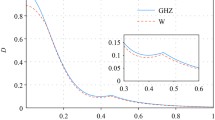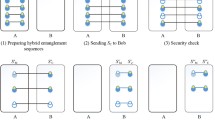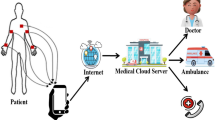Abstract
We have presented a method to estimate parameters of the decoy state method based on one decoy state protocol for SARG04. This method has given lower bound of the fraction of single-photon counts (y 1), the fraction of two-photon counts (y 2), the upper bound QBER of single-photon pulses (e 1), the upper bound QBER of two-photon pulses (e 2), and the lower bound of key generation rate for both BB84 and SARG04. The numerical simulation has shown that the fiber based QKD and free space QKD systems using the proposed method for BB84 are able to achieve both a higher secret key rate and greater secure distance than that of SARG04. Also, it is shown that bidirectional ground to satellite and inter-satellite communications are possible with our protocol.
Similar content being viewed by others
References
Ali S., Wahiddin M.R.B.: Fiber and free-space practical decoy state QKD for both BB84 and SARG04 protocols. Eur. Phys. J. D 60, 405–410 (2010)
Aviv D.G.: Laser Space Communications. Artech House, London (2006)
Branciard C.: Security of two quantum cryptography protocols using the same four qubit states. Phys. Rev. A 72, 032301–032317 (2005)
Cai Q.-y., Tan Y.-g.: Photon-number-resolving decoy-state quantum key distribution. Phys. Rev. A 75, 449–455 (2007)
Curty M. et al.: Passive decoy-state quantum key distribution with practical light sources. Phys. Rev. A 81, 022310–022324 (2010)
Elterman L.: Parameters for attenuation in atmospheric windows for fifteen wavelengths. Appl. Opt. 3(745), 745–749 (1964)
Fung C.-H., Tamaki K., Lo H.-K.: On the performance of two protocols: SARG04 and BB84. Phys. Rev. A. 73, 012337–012356 (2006)
Gatenby P.V., Grant M.A.: Optical intersatellite links. Electron. Commun. Eng. J. 3(280), 280–288 (1991)
Gobby C., Yuan Z.L., Shields A.J.: Quantum key distribution over 122 km of standard telecom fiber. Appl. Phys. Lett. 84, 3762–3764 (2004)
Gottesman D., Lo H.-K., Lütkenhaus N., Preskill J.: Security of quantum key distribution with imperfect devices. Quantum Inf. Comput. 4(325), 325–360 (2004)
Horikiri T., Kobayashi T.: Decoy state quantum key distribution with a photon number resolved heralded single photon source. Phys. Rev. A 73, 032331–032336 (2006)
Hwang W.-Y.: Quantum key distribution with high loss: toward global secure communication. Phys. Rev. Lett. 91, 057901–057905 (2003)
Inamori H., Lütkenhaus N., Mayers D.: Unconditional security of practical quantum key distribution. Eur. Phys. J. D 41, 599–627 (2007)
Koashi M.: Unconditional security of coherent-state quantum key distribution with a strong phase-reference pulse. Phys. Rev. Lett. 93, 120501–120504 (2004)
Li J.-B., Fang X.-M.: Nonorthogonal decoy-state quantum key distribution. Chin. Phys. Lett. 23(4), 757–778 (2006)
Ma X. et al.: Practical decoy state for quantum key distribution. Phys. Rev. A 72, 012326 (2005). doi:10.1103/PhysRevA.72.012326
Meyer-Scott E. et al.: How to implement decoy-state quantum key distribution for a satellite uplink with 50-dB channel loss. Phys. Rev. A 84, 062326–062333 (2011)
Mo X.-F. et al.: Faraday-Michelson system for quantum cryptography. Opt. Lett. 30, 2632–2634 (2005)
Peng C.-Z. et al.: Experimental long-distance decoy-state quantum key distribution based on polarization encoding. Phys. Rev. Lett. 98, 010505–010509 (2007)
Rosenberg D. et al.: Long-distance decoy-state quantum key distribution in optical fiber. Phys. Rev. Lett. 98, 010503–010507 (2007)
Scarani V. et al.: Quantum cryptography protocols Robust against photon number splitting attacks for weak laser pulse implementations. Phys. Rev. Lett. 92, 057901–057904 (2004)
Schmitt-Manderbach T. et al.: Experimental demonstration of free-space decoy-state quantum key distribution over 144 km. Phys. Rev. Lett. 98, 010504–010508 (2007)
Shor P.W., Preskill J.: Simple proof of security of the BB84 quantum key distribution protocol. Phys. Rev. Lett. 85(441), 441–444 (2000)
Tamaki K., Lo H.-K.: Unconditionally secure key distillation from multiphotons. Phys. Rev. A 73, 010302–010305(R) (2006)
Tan Y.G., Cai Q.Y.: Practical decoy state quantum key distribution with finite resource. Eur. Phys. J. D 56, 449–455 (2010)
Ursin R. et al.: Entanglement-based quantum communication over 144 km. Nat. Phys. 3, 481–486 (2007). doi:10.1038/nphys629
Wang X.-B.: Decoy-state protocol for quantum cryptography with four different intensities of coherent light. Phys. Rev. A 72, 012322–012328 (2005)
Wang X.-B.: Decoy-state quantum key distribution with large random errors of light intensity. Phys. Rev. A 75, 052301–052309 (2007)
Wang Q., Wang X.-B., Guo G.-C.: Practical decoy-state method in quantum key distribution with a heralded single-photon source. Phys. Rev. A 75, 012312–012317 (2007a)
Wang X.-B., Peng C.-Z., Pan J.-W.: Simple protocol for secure decoy-state quantum key distribution with a loosely controlled source. Appl. Phys. Lett. 90, 8587–8594 (2007)
Yin Z.-Q., Han Z.-F., Sun F.-W., Guo G.-C.: Decoy state quantum key distribution with modified coherent state. Phys. Rev. A 76, 014304–014308 (2007)
Yin Z.-Q. et al.: Decoy states for quantum key distribution based on decoherence-free subspaces. Phys. Rev. A 77, 062326–062331 (2008)
Yuan Z.L., Sharpe A.W., Shields A.J.: Unconditionally secure one-way quantum key distribution using decoy pulses. Appl. Phys. Lett. 90, 8465–8471 (2007)
Zhao, Yi, et al.: Simulation and implementation of decoy state quantum key distribution over 60 km telecom fiber. In: Proceedings of IEEE International Symposium on Information Theory, pp. 2094–2098 (2006)
Zhao Y. et al.: Quantum hacking: experimental demonstration of time-shift attack against practical quantum-key-distribution systems. Phys. Rev. Lett. 78, 042333–042337 (2008)
Zhou Y.-y., Zhou X.-j.: SARG04 decoy-state quantum key distribution based on an unstable source. Optoelectron. Lett. 7(5), 389–393 (2011)
Author information
Authors and Affiliations
Corresponding author
Rights and permissions
About this article
Cite this article
Ali, S., Mohammed, S., Chowdhury, M.S.H. et al. Practical SARG04 quantum key distribution. Opt Quant Electron 44, 471–482 (2012). https://doi.org/10.1007/s11082-012-9571-2
Received:
Accepted:
Published:
Issue Date:
DOI: https://doi.org/10.1007/s11082-012-9571-2




